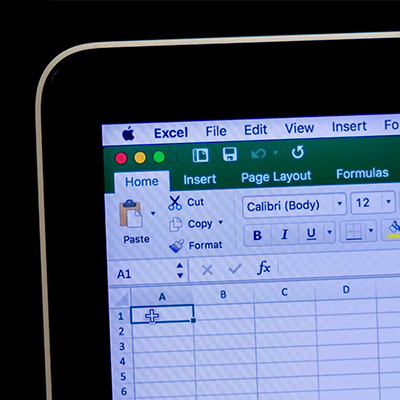In a 2018 Gatepoint Research survey entitled Business Management Trends for Professional Services Firms, 77% of respondents said they use Excel to manage their projects. That same report revealed that manual data entry, the inability to perform analytics or create reports, frustrating interface, and lack of visibility were among the biggest challenges they faced with their project management software.
 Convenience, versatility, and perceived effectiveness make many people believe that spreadsheets can be used for anything. And yes, Excel can be useful for certain project activities, such as to-do lists, limited budget management, and pivot table reports. But when it comes to more advanced project management and project accounting, Excel falls short.
Convenience, versatility, and perceived effectiveness make many people believe that spreadsheets can be used for anything. And yes, Excel can be useful for certain project activities, such as to-do lists, limited budget management, and pivot table reports. But when it comes to more advanced project management and project accounting, Excel falls short.
Here are 6 reasons why using Excel for project management will harm your firm’s productivity, efficiency, and profitability.
1. Limited visibility & incomplete information lead to mistakes
Managing data on a spreadsheet is fine for individuals working on solo projects. But the types of projects that professional services undertake often involve multiple people. As such, using a spreadsheet becomes problematic when more people get involved with entering, processing, and updating data.
Complex projects that involve different steps and phases require constant updates in order to progress smoothly and accurately. Excel makes this coordination difficult, mainly because it requires each team member to make sure they’re working from the most recent file version, and then update and synchronize their individual versions with each other, usually by emailing the file around or uploading to a shared document manager.
This not only opens the team to the risk of missing an update email, it also wastes a lot of time. Working with multiple versions of a spreadsheet make it difficult to know what changes to make, what to do next, and where everything stands.
A common workaround to this is to have a single person responsible for managing a master file. This reduces the potential for working from the wrong file, but increases risk in other ways. First of all, it slows everything down. It requires the person responsible for the master file to constantly bug people to get updates and ask them if they’re done. This not only wastes everyone’s time, it also interrupts the work of other team members and can sour team relationships.
Second, having one person responsible for a master file creates a single point of failure for the project data. Accidental deletion, overwriting, or reformatting can ruin hours of hard work. All it takes is one errant keystroke replacing a formula with a static value on the master file to cripple the entire project.
Working without real-time visibility is like working in a fog, unclear of what’s happening in any given moment, which leads to slow downs as people wait for things to get updated, and this can turn into duplicate work, more mistakes, and missed deadlines.
This “fog of information” makes it impossible to catch and correct problems before they do any significant damage. And once the damage is done, it’s difficult to identify what caused the problems, leaving you vulnerable to the same mistakes in the future.
2. Project details get lost
Excel was not originally designed for project management, so it has limits to its functionality. This becomes particularly true when you have to manage multi-phased projects with many moving parts.
These projects involve a variety of tasks, resources, files, and dependencies across several roles. Spreadsheets have no way of showing these dependencies and thus cannot adjust to fit in new tasks that may arise without advance notice.
For example, if a task or action gets delayed, it’s not easy to make a note of why it was delayed and when it is expected to be completed when using a spreadsheet.
While spreadsheets do a fine job of tracking numbers and calculations, they do a poor job of tracking non-financial information and cannot store files, annotations, conversations, and other related project data. Tracking these details often leads to the need for complex workbooks made up of multiple spreadsheets or even the use of outside files.
Connecting all these details becomes difficult, if not impossible. The use of multiple spreadsheets, especially when they’re installed locally on each individual workstation, can lead to lost, incorrect and overwritten information, rendering the spreadsheets useless.
 And because spreadsheets don’t easily feed project data into other parts of your business, such as invoicing and reporting, your team must rely on time-consuming manual processes to handle those tasks. The pursuit of trying to organize everything in one place transforms into a tangled web without a clear way to track status and progress.
And because spreadsheets don’t easily feed project data into other parts of your business, such as invoicing and reporting, your team must rely on time-consuming manual processes to handle those tasks. The pursuit of trying to organize everything in one place transforms into a tangled web without a clear way to track status and progress.
This creates gaps of information and fragmented communication through which details can fall. Missing key steps in the process leads to budget overruns and missed deadlines.
3. Spreadsheets don’t offer real-time snapshots of the big picture
Making quick and effective decisions becomes difficult when you rely on spreadsheets to track your project information. Due to the collaboration and coordination challenges we’ve discussed, you don’t know if the data you have is up to date.
And while Excel spreadsheets can offer detailed information, they don’t easily provide snapshots of the big picture. In order to summarize project details such as workloads, updates, and roadblocks, you need to create additional views and more tabs.
Instead of a dashboard to see, edit and communicate information in real-time, updates get emailed and multiple versions of the same spreadsheet lead to confusion.
In any case, you may be making decisions based on old or incomplete information, which may be ineffective — or worse — harmful to your performance.
4. Workarounds waste time
It’s human nature to invent workarounds, and this is exactly what happens when teams have to compensate for Excel’s limitations.
A firm ends up captive to a homegrown project management solution built on disparate spreadsheets and workarounds. While this may solve problems in the short term, it’s not sustainable, especially for growing firms. There’s only so far a workaround will go before it reaches its limits and begins to crack under the stress of its own magnitude.
As the number of projects grows, a spreadsheet-based project management system becomes nearly impossible to maintain. Not only will you find it hard to keep consistency across various spreadsheets and workbooks, you’ll also struggle to keep up with all the different elements of a project that you have to track. Multiply that across hundreds of projects and staff, and you end up with a monstrous, labyrinthine mess that slows your entire firm down.
5. Reporting consumes too much time
Excel spreadsheets do not feature built-in reporting and instead require project managers to manually build these reports, which takes time.
Creating specialty reports used in project management, such as Gantt charts, workload reports, project rollups, budgets, and resource allocation, require advanced Excel skills that not every project manager has.
6. Customer support doesn’t exist
When’s the last time you called Microsoft to get support from a real human being when you need help with creating a workaround or when your spreadsheet crashes?
There’s really no way to get real-time, in-person support from Microsoft when you use Excel for project management. in using excel for project management.
 This leaves you and your team searching forums or looking for third-party advice, which again wastes time, slows you down, and isn’t even guaranteed to solve any problems you may encounter.
This leaves you and your team searching forums or looking for third-party advice, which again wastes time, slows you down, and isn’t even guaranteed to solve any problems you may encounter.
Your projects, and your firm, lose money for each minute that goes by without an answer or solution.
You’re only as good as the tools you have
If your firm plans to grow, then it’s time you swapped your spreadsheets for an integrated project management platform that empowers you to get more done with less effort.
BQE CORE solves every problem we’ve discussed in this article with elegance and efficiency, so your team can focus on project delivery instead of burning time and money on project management. CORE is a cloud-based, integrated time billing and project accounting platform that cuts down on data entry and gives you complete visibility into every element of your projects, no matter how complex they may be.
Intuitive business intelligence dashboards provide snapshots of vital information such as KPIs, progress, and budgets. For a deeper dive into the details, CORE produces robust and automated reports, so all project stakeholders have the real-time information they need to steer their projects in the right direction.
Because CORE is an integrated time billing and project accounting platform, your project management data instantly flows to other parts of the platform. This keeps your projects on schedule and under budget, while keeping your staff productive, efficient, and effectively utilized.
While no one can plan perfectly for the future, there are many project management pitfalls that you can easily prevent. Download our ebook below to learn how to avoid these mistakes.
